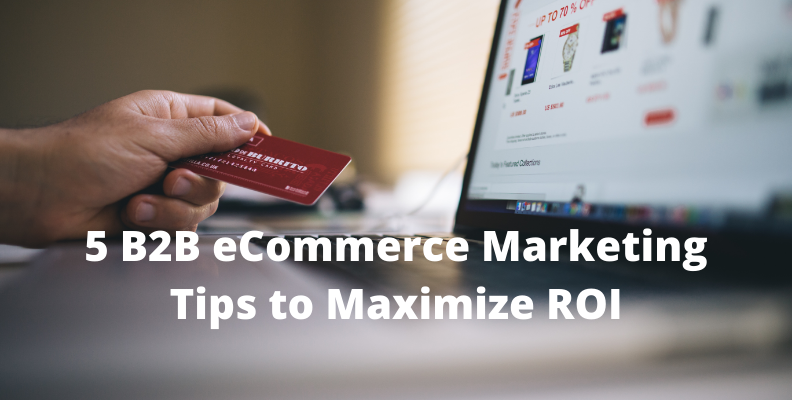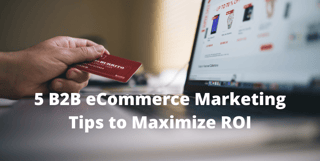
So you've decided that creating an eCommerce store or marketplace for your B2B business is the right move for you. Congratulations!
You've astutely recognized the changing purchasing behaviors of a younger generation of buyers within your industry who have expectations of being able to do business on their terms - mainly digitally. It's no wonder that sales in the US processed through B2B eCommerce sites hit just over $1 trillion! And that was in 2018...
With more and more businesses considering the move from a traditional purchasing process that includes human to human interaction and guidance, there's an increasing need for direction and support on how to successfully make this major business transformation. So, we asked the eCommerce consultants at Revenue River for some helpful tips to guide decision-making, store build-out, and content creation all with the goal of maximizing your ROI.
Read on to find out what must be considered for success.
Tip 1 - See eCommerce as Your Competitive Advantage
Jenna Bos, Revenue River's Senior Client Success Manager, had this to say about setting an organization's paradigm during an eCommerce buildout:
"When it comes to B2B e-commerce, I’ve seen organizations nervous about implementing, particularly if they’re first in their industry. In contrast I would say that you can think of e-commerce as a competitive advantage with little risk but lots to gain, and sets you apart from your competitors."
Implementing an eCommerce store for your B2B business is not just a digital marketing and sales decision, it's a business decision. Your store should have the necessary buy-in and strategic direction from executive decision makers just as much as from your marketing and sales leadership if you want to see success. More on the latter next.
Tip 2 - Get Your Sales Team on Board & Supporting The Build Process
If you're like many other B2B companies considering an eCommerce transition, you will most likely have a sales team that drives business for you up until this point. It's important that they don't view the introduction of the new eCommerce tool as a major threat but instead as a new sales tool that they can use to improve close times and reduce energy spent per lead. By talking to your team, not only will you be able to get valuable information on how best to set up your system to optimize the purchasing process (more on that below) but you can also better understand how you can implement beneficial elements for them on the front and back side of that purchasing process through marketing and sales enablement content and automation.
It all starts with an honest conversation.
Tip 3 - Fully Understand and Then Optimize the Purchasing Process With eCommerce
Just like any other marketing or sales initiative, a full understanding of the customer's journey is absolutely necessary in order to make informed decisions. When building your eCommerce store, talk to your customers, sales team and other team members connected to fulfillment to fully understand what the purchasing process looks like - from the buyer's needs, stages of decision-making, and post-purchase requirements - so that you can properly optimize your store to meet the needs and expectations of external AND internal stakeholders.
Tip 4 - Build an Integrated & Seamless Experience Between Your Informational & eCommerce Sites
Jenna Bos again:
"In general, don’t think of your e-commerce store as something entirely separate from the rest of the site, or your users will feel it’s an entirely separate experience too, limiting adoption. When possible, be strategic about leveraging the rest of your digital marketing system to drive relevant, educated traffic to store pages. If you have the resources it’s possible to seamlessly integrate product pages into your website in areas that make sense to the buyers journey."
Be sure to control the narrative of your new eCommerce store's implementation by considering the user's experience. By thoughtfully connecting the dots between the existing content you have on your website with your new store's pages, you'll be sure to show your visitors and customers that you have implemented a new AND improved digital experience for them, not just a new section of the site.
Tip 5 - Create Supporting Content to Compliment Your Product Pages & Purchasing Process
Julie Casseaux, Revenue River's eCommerce Strategist responsible for store builds, integrations, and implementations, had this to say about new content to consider supporting the eCommerce purchasing process:
"B2B purchases aren't typically impulse buys, so you must ensure that your buyers have access to content that supports the purchasing process much like a sales person would need to have in a traditional sales cycle. This includes sales sheets, competitor comparison content, custom pricing, and other sales tools."
In connection to tip 3, Julie hones in on a key insight that many B2B eCommerce stores miss initially. Just because you're allowing for digital purchasing doesn't mean that your buyers will all of a sudden treat the purchase like an Amazon Prime order. Support your buyers with the information that they need in a way that allows them and their stakeholders to easily make a true B2B purchasing decision.
Building any eCommerce store takes a lot of time, energy, and resources to successfully execute and roll-out, no matter the type of business. For B2B companies considering the move from a traditional sales approach to a digital storefront, these 5 tips are a great starting point to help you find success and ultimately ROI. For expertise in these and the smaller details surrounding the actual customization and implementation, talk to our team at Revenue River.

